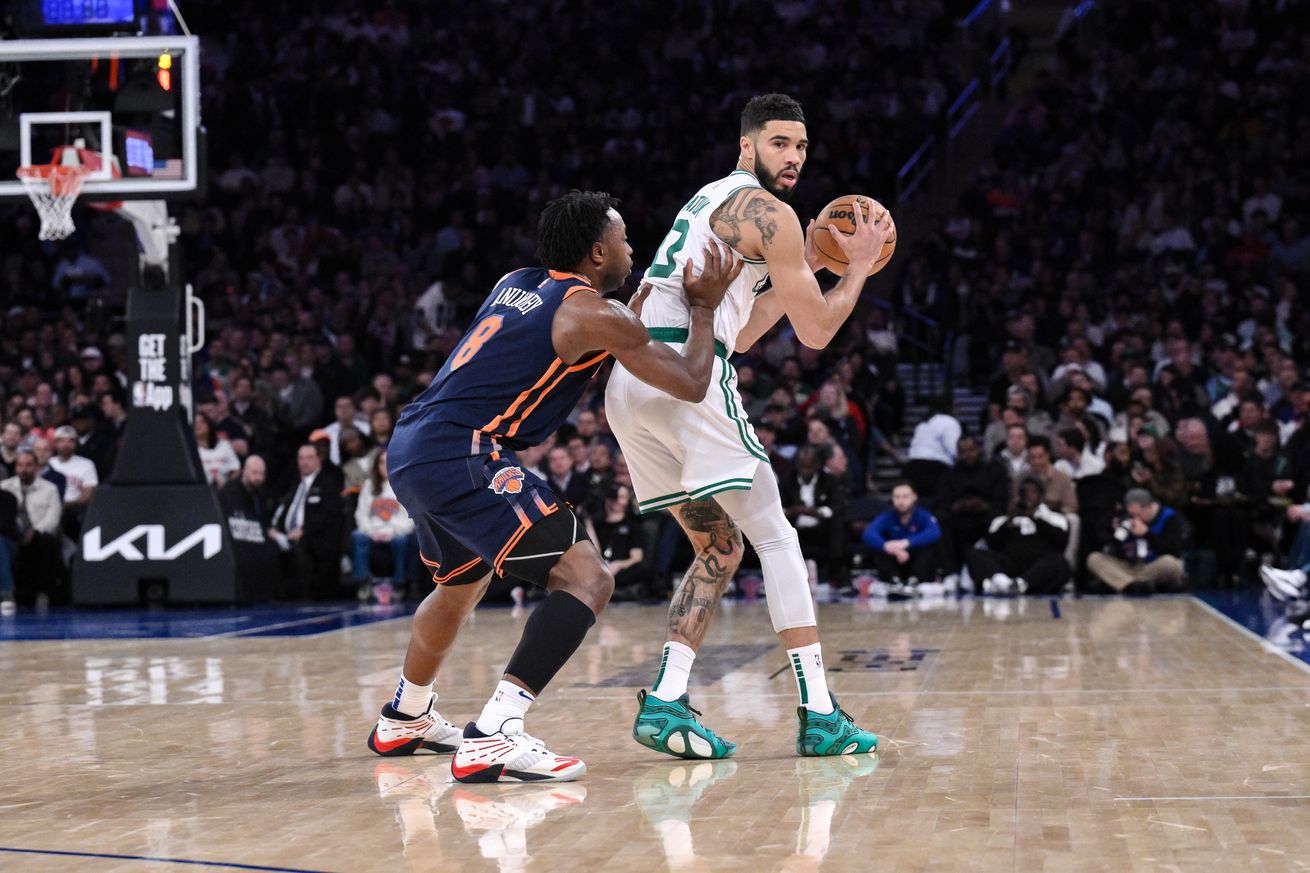
The Celtics leaned on this action all season, and the Knicks never solved it. With layers like Spain pick-and-rolls, Stagger actions or Zoom actions, Boston is ready to exploit every gap.
One of the keys against the New York Knicks will be the Jayson Tatum pick-and-roll game. Over four games of the regular season, Tom Thibodeau’s teams couldn’t find an answer to it. The Celtics can run different plays with various options. Also, defenses can try numerous coverages and try to stop the offense from getting what they want.
Let’s first look into the different variations of the pick-and-roll built around Jayson Tatum, then we’ll deep dive into the possible defensive approaches.
Why it works?
The ultimate goal of basketball is to create a gap, an advantage that the best players can take advantage of. Teams are looking to create a two-on-one, three-on-two, four-on-three, or five-on-four situation in offense. The most basic way to do so is to set a screen and force the defense to make a decision.
In the Boston Celtics’ first play of the season, they ran two pick-and-rolls. The first one with Jrue Holiday and Derrick White, but the screen didn’t create an advantage and the Knicks didn’t switch. Therefore, the Celtics tried another one with Jayson Tatum and Al Horford.
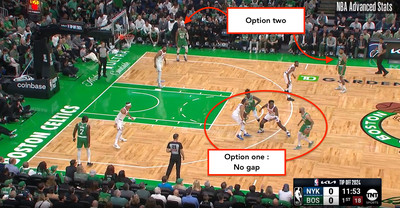
Because of the quickness of Horford to set a screen, Karl-Anthony Towns is a little behind, but that’s not too much of a problem because, like most of the time, they are in a drop coverage. This means the player on the ball-handler has to fight above the screen, and the screener’s defender stays low.
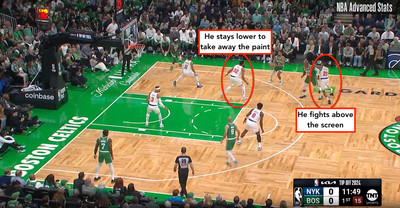
This is where the trouble starts for New York. This would work against a player without a pull-up threat from beyond the line. But Jayson Tatum is part of that class of players that will punish you for using this coverage, and that’s why the Knicks are in trouble.
Jayson Tatum can make it rain from three, but the Celtics can also use the Spain pick-and-roll to punish the drop coverage. The Spain pick-and-roll is a variation that brings another player behind the first screener. He sets a screen on the original screener and makes it harder to move backward, which turns the drop coverage into a complete mess.
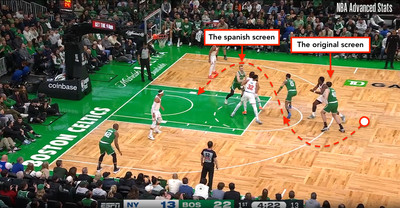
Jayson Tatum’s ball-handling ability gives him enough control to snake the pick-and-roll and go from the left, to the right, back to the left. Because of the second screen in the back on KAT, nobody protects the rim. Note that it’s Hauser who sets the screen. Why? Because he is defended by the weakest and smallest defender on the Knicks and won’t be able to help in the paint.
Another example of Tatum’s ball-handling improvement is in the play below where Towns is higher, not totally in drop coverage. Despite having less space to manipulate the defense, he is able to split the pick-and-roll and go in the middle of it, in between Brunson and Towns. After that, the other three players are too far to help, or too small (notice Miles McBride as a low man).
To impact the position of Towns, the Celtics also used what is called a ram screen. It is a screen from a guard (usually the one defended by Brunson here) for the player who will set the screen on the ball. This forces KAT to fight over one screen before getting into the position of defending the pick-and-roll. Because he is a step behind, Tatum is a step ahead and can use his shooting, driving, or passing to make it work.
The Celtics also used two screens on the ball against the Knicks—a double drag action with a screen from Luke Kornet and a screen from Payton Pritchard. Then, after they set screens, they are on the move to generate more chaos.
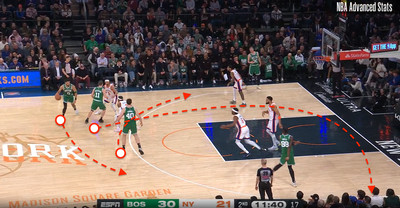
Pritchard goes to the corner and will benefit from an exit screen from Neemias Queta, while Kornet will set a pindown screen for Sam Hauser. Two screens on the ball, then two off-ball screens, plus Tatum’s scoring gravity… good luck with that one!
To make it even harder to guard, the Celtics used Jayson Tatum in a zoom action. It’s similar to the action above with two screens, but Tatum starts the play without the ball. He goes through two screens, the second one being a handoff. This gives him more speed and creates even more chaos within the defense.
With Kristaps Porzingis as a screener, the Celtics can also use a pick-and-pop action to force the defense to cover even more space. Against drop coverage or even more aggressive defensive approaches, this works well with such an elite shooter.
Speaking of defensive coverage, let’s look at what the Knicks tried.
Bullet proof?
What makes the Jayson Tatum pick-and-roll impossible to stop for the Knicks is not only the Celtics’ go-to guy’s skills, but also due to who he plays with. First, the screens are often set by Kornet, one of the best screen setters in the NBA. Horford is pretty good at it too, while Porzingis is softer on his screens, but his shooting range makes it work.
Then, next to the two-man games, you can find some of the best shooters in the league: Pritchard, Hauser, and White, who are all deadly from three this season. You could also use Jaylen Brown’s scoring gravity or Jrue Holiday’s ability to connect. In the next play, for example, the Knicks are trying a hard hedge. This means Towns doesn’t stay below the level of the screen but goes above it to slow down Tatum.
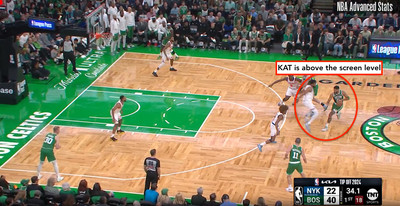
On top of that, Miles McBride comes and stunts to also force Tatum to stop his drive. But Tatum is able to stay calm and collected and understands fully that if two or three players are on him, some of his teammates are alone. Here, for example, it’s Pritchard who is free to connect from beyond the line.
Against aggressive defense, the Celtics could also use a third player to facilitate the play. It’s called a short action and was popularized by Mike D’Antoni with Steve Nash when defenses were putting a lot of pressure on him. In the example below, because Tatum is swamped and can’t get the ball to the roll-man, he uses Holiday as a third party in the pick-and-roll action.
Against the hedge defense, Jayson Tatum’s size is also very useful to find the player on the short roll. Because he can pass above his defenders, the roll-man can be found. In the play below, Kornet gets the ball at the free-throw line and the help from the rim comes.
Because the Celtics are great at court mapping, White is waiting at the dunker spot, and that’s hard to deal with. Kornet forced the defense to rotate with the pass to Pritchard, White relocated, and that’s a triple.
Sending two players like this on Jayson Tatum has another negative effect for the New York Knicks: it gives Kornet the space to dominate on the offensive rebound. With two players on the ball, one of them being the center, the Celtics have a clear advantage for when Tatum misses the pull-ups.
The Knicks could be tempted to crowd the paint and force Tatum to make difficult passes, but as he gets older, his passing has improved a lot. Here, he noticed the weak-side help from McBride and sent a bullet pass to White on the other side of the court.
One solution could be to switch, but the Celtics will be constantly screening with the players who will offer the mismatch. Most often, the important part of the pick-and-roll action for the Celtics isn’t who is the screener, but who he is defended by. That’s why you don’t switch.
Overall, because of Jayson Tatum’s skillset, the Boston Celtics’ supporting cast, and the New York Knicks’ defensive weak spots, I don’t see a world where this action isn’t going to blow the Knickerbocker defense wide apart.